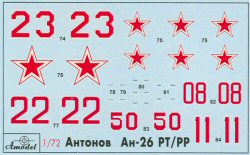
Amodel 1/72 An-26 Curl Kit First Look
By Michael Benolkin
| Date of Review | April 2006 | Manufacturer | Amodel |
|---|---|---|---|
| Subject | An-26RR/RT/Z Curl | Scale | 1/72 |
| Kit Number | 72134 | Primary Media | 251 parts, 249 in styrene, 2 in photo-etch |
| Pros | Nice detailing | Cons | No mission equipment inside the cargo compartment |
| Skill Level | Intermediate | MSRP (USD) | $51.48 |
First Look
 |
 |
 |
 |
 |
 |
 |
 |
 |
 |
 |
 |
 |
The Antonov Design Bureau developed a regional passenger aircraft in 1959 that was similar in design to the Fokker F-27 Friendship released a few years earlier. The An-24 (NATO Codename: Coke) shared a similar high-wing, twin-engined turboprop configuration, right down to the main gear being stowed in extended engine nacelles. A militarized version of the aircraft, the An-24T followed in 1967 with 164 examples being produced.
During the production of the An-24, further enhancements to the basic design were considered to enhance its military utility. The main difference was a change in the tail to accommodate a loading ramp to allow drive-on/drive-off cargo carriage as well as parachute delivery of cargo and personnel. This updated design was designated An-26 (NATO Codename: Curl).
The An-26 was a versatile aircraft and was adopted into a variety of support missions. The An-26RT was a radio-relay platform (the airborne precursor to the communications satellite). The An-26RR was evidently a radioactive event detector, whereas the An-26Z was tactical battlefield control configuration smaller but similar to the E-8 JSTARS.
Amodel of Russia has released a nice 1/72 scale rendition of the Antonov An-26. The box art revealed that this kit was honored with a Modellfan award. Looking this kit over, I can easily see why.
Molded in white styrene, this kit is presented on 21 parts trees plus two additional trees of clear parts. The kit has all of the parts of the standard An-26 airlifter plus the additional bumps and blade antennas for rendering the An-26RR, An-26RT, or An-26Z.
With 251 parts for a 1/72 scale project, I listed this kit at an Intermediate skill level since there will some parts clean-up and dry-fitting required to get a clean build. While there doesn't appear to be any significant design problems, there are loads of small parts that will require care and experience to assemble without undue frustration.
Assembly of the kit (naturally) begins in the cockpit. The flight deck is nicely appointed and will give the casual observer looking through the windows something nice to see. The interior of the cargo bay is next, and while this does have a fairly nice interior fuselage, cargo floor, and internal fittings, you'll want to keep the ramp closed if you're building any of the three special-mission aircraft as there are no equipment racks, crew consoles, or other mission equipment that you'd expect for these variants. If you are building the vanilla airlifter, then by all means, you'll want to show off that nice cargo compartment interior!
The engine nacelles are next, and this kit accurately captures the three engines of the An-26. That's right, three. The An-26 not only has the two turbo-prop engines, but it also has a small turbojet engine in the starboard nacelle to serve as an auxiliary power unit (APU). This 'APU' can also create around 1200 pounds of thrust for some additional 'push' during take-off.
The wings are going to be fairly long after assembly. They consist of a center section and two outboard sections that attach outboard of the engine nacelles. While simple liquid cement should build a strong wing, I plan on using a Plastruct I-beam for a main spar just to make sure the three wings sections stay together while being handled.
With the wings and tail section installed, it is now time to decide which version you're really going to build. Each of the three special mission aircraft receive different pods, antennas, etc., depending on your choice. Of course you can leave off all of the special stuff and stick with the airlifter too.
Markings are provided for six versions:
- An-26RT, Red 11, 50 OSAP, Soviet Air Force, Kabul, 1987
- An-26RT, Red 22, 50 OSAP, Soviet Air Force, Kabul, 1986
- An-26RR, Red 50, Soviet Air Force
- An-26RT, Red 20, 243 OSAP, Ukrainian Air Force, L'vov, 1992
- An-26Z, 3209, Czech Air Force
- An-26 (airlifter), 2409, Czech Air Force
In addition to the distinctive aircraft markings and national insignia, the decals also provide a nice array of aircraft maintenance stenciling as well.
This is a nice little kit that will build into a unique subject with a little patience and skill. The AMS modeler will have fun with this project and have a variety of color schemes to round out the experience.
My sincere thanks to Hobbyshop.cz for this review sample!







